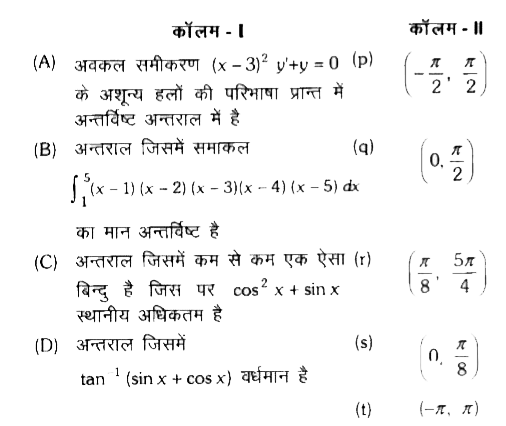कॉलम I में दिये गये वक्तव्यों का कॉलम II में दिये अंतरालों अथवा अंतरालों के सम्मिलन से सुमेल करें
कॉलम -Iकॉलम - II(A)समुच्चय{Re(2iz1−z2):zएकसम्मिश्र संख्या है|z|=1,z≠±1}है(p)(−∞,−1)∪(1,∞)(B)फलनf(x)=sin−1(8(3)x−21−32(x−1))का प्रान्त है(q)(−∞,0)∪(0,∞)(C)यदिf(θ)=∣∣
∣∣1tanθ1−tanθ1tanθ−1−tanθ1∣∣
∣∣,तब समुच्चय{f(θ):0≤θ<π2}है(r)[2,∞)(D)यदिf(x)=x3/2(3x−10),x≥0,तबf(x)किसमे वर्धमान है(s)(−∞,−1]∪[1,∞)(t)(−∞,0]∪[2,∞)
The correct Answer is:A→s;B→t;C→r;D→r
Topper's Solved these Questions
- अवकलन तथा अवकलज के अनुप्रयोगBOOK - ERRORLESS HINDICHAPTER - अवकलन तथा अवकलज के अनुप्रयोगEXERCISE - JEE Advanced (Integer type questions)
30 Videos
- अवकल समीकरण BOOK - ERRORLESS HINDICHAPTER - अवकल समीकरण EXERCISE - JEE Advanced ( Matrix Match type questions )
3 Videos
- केन्द्रीय प्रवृत्ति के मापBOOK - ERRORLESS HINDICHAPTER - केन्द्रीय प्रवृत्ति के मापEXERCISE - Jee Advanced (Reasoning )
2 Videos
Similar Questions
वास्तविक संख्याओं a−5,a−4,3a−3,1,a8 और a10 का निम्नतम योग ,जबकि a>0 है , होगा
View Solution
View Solutionकथन - 1 : प्रथम n सम धन पूर्णांकों का प्रसरण n2−14 है।
कथन - 2 : प्रथम n धन पूर्णाको का योगफल n(n+1)2 और प्रथम n धन पूर्णांको के वर्गों का योगफल n(n+1)(2n+1)6 है।
View SolutionThe domain of f(x)=log|logx|is (0,∞) (b) (1,∞) (c) (0,1)∪(1,∞) (d) (−∞,1)
View SolutionThe domain of the function f(x)=sin−1(3−x)In(|x|)−2 is
View SolutionThe solution set of the inequality max {1−x2,|x−1|}<1 is (−∞,0)∪(1,∞) (b) (−∞,0)∪(2,∞) (0,2) (d) (0,2)
View SolutionSolution set of the inequation x2+4x+42x2−x−1>0, is x∈(−∞,−2)∪(−2,1) x∈(−∞,−2)∪(−2,−12)∪(1,∞) x∈(−∞,−2)∪(−12,1)∪(1,∞) x∈(−∞,1)
View SolutionSolution set of inequality (ex−1)(2x−3)(x2+x+2)(sinx−2)(x+1)2x≤0 is [32,∞) b. (−∞,−1)∪[32,∞) c. [−1,0)∪[32,∞) d. R−{0,−1}
View SolutionThe intervals of increase of f(x) defined by f(x)=∫x−1(t2+2t)(t2−1)dt is equal to (−∞,−32)∪(0,3)∪(10,∞) (−∞, −2)∪(−12,12)∪(4,∞) (−∞, −2)∪(−1,0)∪(1,∞) (−∞, −2)∪(−34,14)∪(1,∞)
View SolutionThe range of (x ^ (2) -2x + 3) / (x ^ (2) -2x-8) AA x in R is (i) (- oo, 0] uu [1, oo) (ii) [ (1) / (2), 2] (iii) (- oo, - (2) / (9)] uu [1, oo) (iv) (oo, -6] uu ([- 2, oo)
View SolutionThe domain of the function f(x)=sin−1(|x|+5x2+1) is
(−∞,−a]∪[a,∞). then a is equal to :
View SolutionThe domain of f(x)=log|logx|is (0,∞) (b) (1,∞) (c) (0,1)∪(1,∞) (d) (−∞,1)
View SolutionIf f(x)={x3,ifx2<1andx,ifx2≥1 then f(x) is differentiable at (a) (−∞,∞)−{1} (b) (−∞,∞)−{1,−1} (c) (−∞,∞)−{1,−1,0} (d) (−∞,∞)−{−1}
View SolutionThe domain of f(x)=34−x2+log10(x3−x) (1) (−1,0)∪(1,2)∪(3,∞) (2) (−2,−1)∪(−1,0)∪(2,∞) (3) (−1,0)∪(1,2)∪(2,∞) (4) (1,2)∪(2,∞)
View Solutionकॉलम I में दिये गये वक्तव्यों का कॉलम II में दिये अंतरालों अथवा अंतरालों के सम्मिलन से सुमेल करें
कॉलम -Iकॉलम - II(A)समुच्चय{Re(2iz1−z2):zएकसम्मिश्र संख्या है|z|=1,z≠±1}है(p)(−∞,−1)∪(1,∞)(B)फलनf(x)=sin−1(8(3)x−21−32(x−1))का प्रान्त है(q)(−∞,0)∪(0,∞)(C)यदिf(θ)=∣∣ ∣∣1tanθ1−tanθ1tanθ−1−tanθ1∣∣ ∣∣,तब समुच्चय{f(θ):0≤θ<π2}है(r)[2,∞)(D)यदिf(x)=x3/2(3x−10),x≥0,तबf(x)किसमे वर्धमान है(s)(−∞,−1]∪[1,∞)(t)(−∞,0]∪[2,∞)
View Solution
